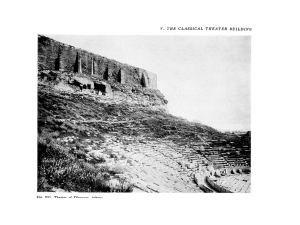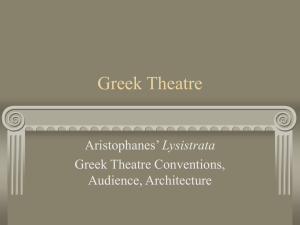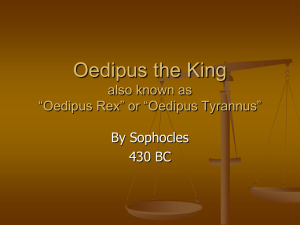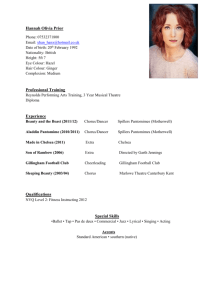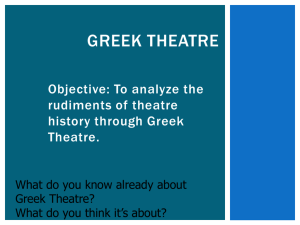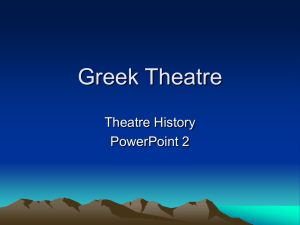Chapter 1: Origins of Theatre Little information about the origin of
advertisement
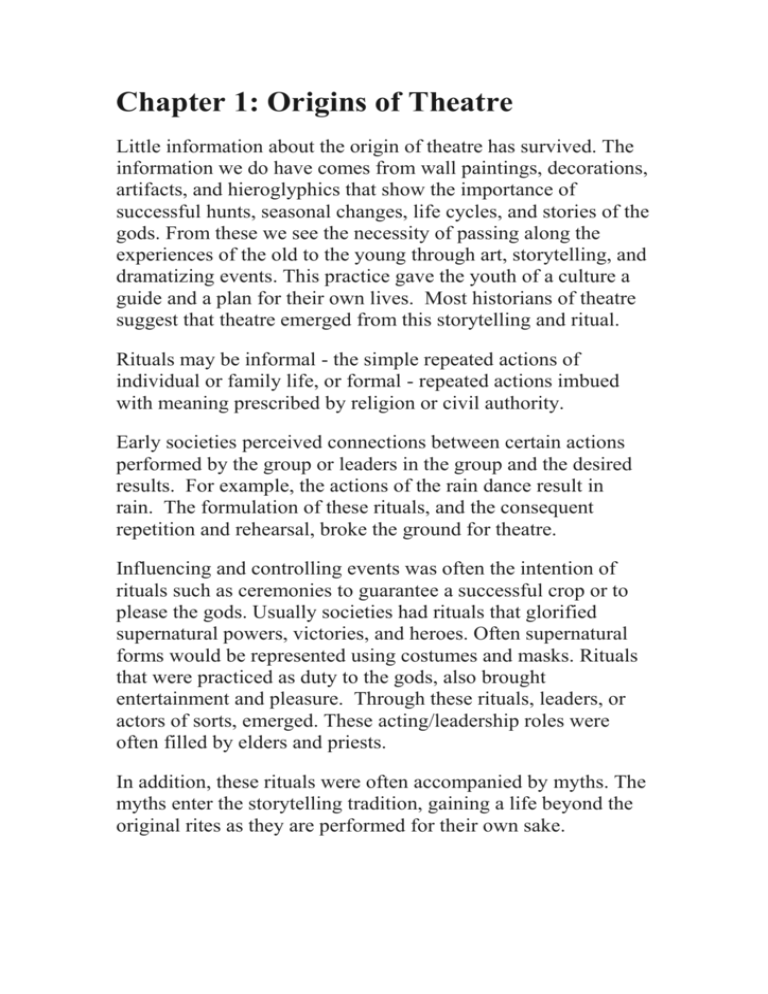
Chapter 1: Origins of Theatre Little information about the origin of theatre has survived. The information we do have comes from wall paintings, decorations, artifacts, and hieroglyphics that show the importance of successful hunts, seasonal changes, life cycles, and stories of the gods. From these we see the necessity of passing along the experiences of the old to the young through art, storytelling, and dramatizing events. This practice gave the youth of a culture a guide and a plan for their own lives. Most historians of theatre suggest that theatre emerged from this storytelling and ritual. Rituals may be informal - the simple repeated actions of individual or family life, or formal - repeated actions imbued with meaning prescribed by religion or civil authority. Early societies perceived connections between certain actions performed by the group or leaders in the group and the desired results. For example, the actions of the rain dance result in rain. The formulation of these rituals, and the consequent repetition and rehearsal, broke the ground for theatre. Influencing and controlling events was often the intention of rituals such as ceremonies to guarantee a successful crop or to please the gods. Usually societies had rituals that glorified supernatural powers, victories, and heroes. Often supernatural forms would be represented using costumes and masks. Rituals that were practiced as duty to the gods, also brought entertainment and pleasure. Through these rituals, leaders, or actors of sorts, emerged. These acting/leadership roles were often filled by elders and priests. In addition, these rituals were often accompanied by myths. The myths enter the storytelling tradition, gaining a life beyond the original rites as they are performed for their own sake. Finally, the beginnings of acting spaces or auditoriums developed as a result of more elaborate rituals and the need to hold and separate spectators and actor/leaders. Questions for Review: 1. How did ancient people pass along the experiences of the old to the young? 2. From what two sources does theatre emerge? 3. According to the reading, what is a ritual? 4. Who filled the acting/leadership roles that emerged through the practice of ritual? Chapter 2: Theatre and Drama in Ancient Greece The Greeks' theatre history began around 700 B.C. with festivals honoring their many gods. One god, Dionysus, was honored with an unusual festival called the Dionysia. The revelry-filled festival was led by drunken men dressed up in rough goat skins (because goats were thought sexually potent) who would sing and play in choruses to welcome Dionysus. at the "Great" or "City" Dionysia in Athens, tribes competed against one another in performances, and the best show would have the honor of winning the contest. Of the four festivals in Athens (each reflecting seasonal changes), plays were only presented at one festival--the City Dionysia. Historians believe that the Greeks patterned their celebrations after the traditional Egyptian pageants honoring Osiris. At the early Greek festivals, the actors, directors, and dramatists were all the same person. The cast consisted of one or more actors and a chorus of many. Later, only three individual actors were allowed in each play. Because of the limited number of actors allowed on-stage, the chorus evolved into a very active part of Greek theatre. Though the number of people in the chorus is not clear, the chorus was given as many as one-half the total lines of the play. Music was often played during the chorus' delivery of its lines. Although few tragedies written from this time actually remain, the themes and accomplishments of Greek tragedy still resonate to contemporary audiences. The term tragedy (tragos and ode) literally means "goat song," after the festival participants' goatlike dancing around sacrificial goats for prizes. Most Greek tragedies are based on mythology or history and deal with characters' search for the meaning of life and the nature of the gods. Most tragedies that have survived from this period begin with a prologue, an exposition given by the principle actor setting the stage for the audience. Next, during the parados, the chorus introduces the characters, exposition is given, and a mood is established. Episodes convey the action of the play through dialogue between the actors or between the actors and the chorus. The final scene is called the exodus when all the characters as well as the chorus depart. In addition to the plot choreographed movement was also important to the performance. Plays were performed in large, open-air structures consisting of a semi circular terraced theatron or "seeing place”, and a round orchestra, the “dancing place” of the chorus and the chief performance space. An altar of Dionysus was usually located in the center of the orchestra. A temporary structure called a skene on the far side of the orchestra served as a backdrop for the action and was where the actors stored their masks and costumes and performed quick changes out of the sight of the audience. On either side of the skene were parodoi, that led into or away from the orchestra. These were used for the entrances and exits of the chorus. The three best-known Greek tragedy playwrights of the fifth century are Aeschylus, Sophocles, and Euripedes. Aeschylus, who was a competitor at the City Dionysia around 499 B.C., wrote some of the oldest tragedies in the world. Only a few of Aeschylus' plays have survived but they include The Persians and the Oresteia trilogy. Aeschylus is attributed with the introducing the second actor to the stage and inventing the trilogy. Only seven of Sophocles tragedies--including the still-popular Antigone, Electra, and Oedipus Rex--have survived. Sophocles won twenty-four contests for his plays, never placing lower than second place. His contributions to theatre history are many: He introduced the third actor to the stage, fixed the number of chorus members to fifteen, and was the first to use scene painting. Sophocles' plays explore the boundaries between fate and the free will. Euripedes was prolific playwright who is believed to have written 90 plays, 18 of which have survived, including Medea, Hercules and The Trojan Women. He was often criticized for the way he questioned traditional views of the role of women and obedience to authority. Euripedes also explored the psychological motivations of his characters actions which had not been explored by other authors. His plays were used as pattern for other authors for many years after his death. Comedy was also an important part of ancient Greek theatre. No one is quite sure of the origins of comedy, but it is said that they derived from imitation. All comedies of note during this time are by Aristophanes . Aristophanes, who competed in the major Athenian festivals, wrote 40 plays, 11 of which survived-including the most controversial piece of literature to come from ancient Greece, Lysistrata, a humorous tale about a strong woman who leads a female coalition to end war in Greece. Although only 33 tragedies and 11 comedies remain from such a creative period, the Greeks were responsible for the birth of drama in the Western world. Questions for Review: 1. How doe the text describe the festival of Dionysia? Which god did it honor? 2. Why was the Great or City Dionysia important in theatre history? 3. What does the term "tragedy" literally mean? Where does this come from? 4. Describe some parts of a typical Greek tragedy from this time period. 5. In a Greek theatre what was the “dancing place” of the chorus called? 6. Who were the three well-known Greek tragedy playwrights of the fifth century? Give one significant contribution they made or the title of a play that each wrote. 7. Who was the most important writer of comedy from that time period?
